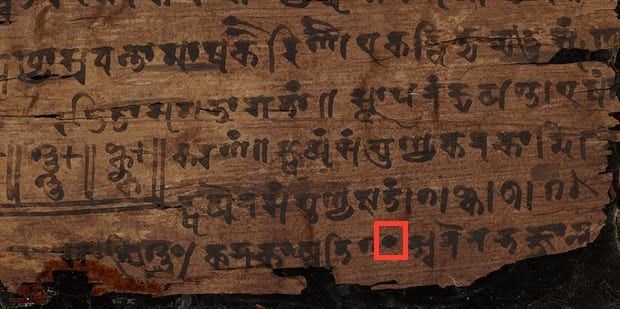When Was Zero Invented? Ancient Text Reveals Mathematical Concept's Origins

Scientists have found the earliest recorded usage of a zero, marking a historical turning point in mathematics and society.
The Bodleian Libraries at Oxford University announced the discovery from an ancient Indian mathematical document called the Bakhshali manuscript, which was discovered in the late 1800s in what is now Pakistan but has recently been reanalyzed. The text, which is littered with zeroes, has been dated to between 200 and 400 BCE, placing it about 500 years earlier than the next known use of the mathematical symbol.
“This isn’t some sort of theoretical text, it seems to be a practical document that is being used by merchants to do calculations,” mathematics professor Marcus du Sautoy said in a video from Oxford. Those calculations, which include dots that are supposed to be zeroes, were made on dozens of birch bark leaves. Although previous civilizations had previously identified the concept of nothingness and had symbols to represent that concept, it is different from this text on which someone was performing mathematical calculations with a zero, using a symbol that evolved into its own number and became the doughnut-shaped character we know today.
A leaf from the Bakhshali Manuscript, showing off Indian mathematical genius. A zero symbol has been highlighted in the second image. pic.twitter.com/65iZpEVkld
“This becomes the birth of the concept of zero in its own right,” the professor said. It shows the ability of ancient people “to conceive of the void, to conceive of the infinite.”
The entire history of the zero’s invention is still unclear, but the library notes that what is now clear is that it happened before the ninth century, the time when a zero was made on a temple wall in Gwalior, India. Before the Bakhshali manuscript discovery, experts had thought that temple inscription was the first written proof of the number’s existence.
In the manuscript, the dot representing zero was a placeholder: “meaning it was used to indicate orders of magnitude in a number system — for example, denoting 10s, 100s and 1000s,” the libraries explained.
“Zero as a concept, we’re all completely used to but … it must have been quite a revolutionary idea,” radiocarbon dating scientist David Chivall said in the Bodleian Libraries video.
Creating the idea of a numerical value for nothingness was a huge step forward in mathematics, du Sautoy said.
“We now know that it was as early as the 3rd century that mathematicians in India planted the seed of the idea that would later become so fundamental to the modern world,” he said. “The findings show how vibrant mathematics have been in the Indian subcontinent for centuries.”
While the Bakhshali manuscript has been housed at Oxford since 1902 and was already known to be the oldest Indian mathematical text, scientists were not sure exactly how old it was. The recent radiocarbon dating performed on the document proved it to be between 1,600 and 1,800 years old.
Part of what made it so difficult to date was the material it was written on — those dozens of birch bark leaves comprising the fragile paper came from three different time periods, according to Oxford University.
“Determining the date of the Bakhshali manuscript is of vital importance to the history of mathematics and the study of early South Asian culture and these surprising research results testify to the subcontinent’s rich and longstanding scientific tradition,” librarian Richard Ovenden said in the university statement.
© Copyright IBTimes 2024. All rights reserved.




















